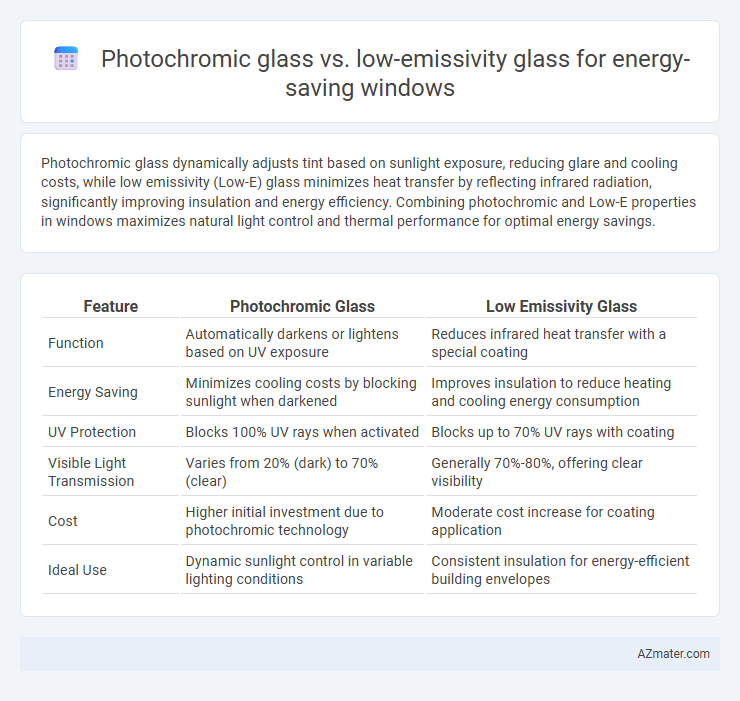Photochromic glass dynamically adjusts tint based on sunlight exposure, reducing glare and cooling costs, while low emissivity (Low-E) glass minimizes heat transfer by reflecting infrared radiation, significantly improving insulation and energy efficiency. Combining photochromic and Low-E properties in windows maximizes natural light control and thermal performance for optimal energy savings.
Table of Comparison
| Feature | Photochromic Glass | Low Emissivity Glass |
|---|---|---|
| Function | Automatically darkens or lightens based on UV exposure | Reduces infrared heat transfer with a special coating |
| Energy Saving | Minimizes cooling costs by blocking sunlight when darkened | Improves insulation to reduce heating and cooling energy consumption |
| UV Protection | Blocks 100% UV rays when activated | Blocks up to 70% UV rays with coating |
| Visible Light Transmission | Varies from 20% (dark) to 70% (clear) | Generally 70%-80%, offering clear visibility |
| Cost | Higher initial investment due to photochromic technology | Moderate cost increase for coating application |
| Ideal Use | Dynamic sunlight control in variable lighting conditions | Consistent insulation for energy-efficient building envelopes |
Introduction to Energy-Saving Windows
Energy-saving windows utilize advanced glass technologies to reduce heat transfer and improve building efficiency. Photochromic glass dynamically adjusts its tint in response to sunlight, reducing glare and cooling loads by controlling solar heat gain. Low emissivity (Low-E) glass features a microscopically thin coating that reflects infrared energy while allowing visible light, minimizing heat loss in winter and heat gain in summer.
Understanding Photochromic Glass
Photochromic glass dynamically adjusts its tint in response to sunlight, reducing solar heat gain and glare while allowing natural light to enter, which significantly enhances energy efficiency in buildings. Unlike low emissivity (Low-E) glass, which primarily minimizes heat transfer by reflecting infrared radiation, photochromic glass actively adapts to changing light conditions, providing variable shading and improved occupant comfort. This smart glazing technology reduces reliance on artificial cooling and lighting, making it a sustainable choice for energy-saving window solutions.
What is Low Emissivity (Low-E) Glass?
Low Emissivity (Low-E) glass features a microscopically thin metal or metallic oxide coating that minimizes infrared and ultraviolet light without compromising visible light transmission, enhancing energy efficiency in windows. This coating reflects interior temperatures back inside during winter and blocks solar heat gain in summer, reducing heating and cooling costs. Compared to photochromic glass, Low-E glass provides consistent insulation benefits regardless of light conditions, making it ideal for energy-saving window applications.
How Photochromic Glass Works for Energy Efficiency
Photochromic glass enhances energy efficiency by automatically darkening in response to sunlight, reducing heat gain and glare without compromising visibility. This dynamic tint adjusts based on UV light exposure, minimizing the need for artificial cooling and lowering energy consumption in buildings. Unlike low emissivity glass, which primarily blocks infrared radiation, photochromic glass actively modulates natural light, optimizing indoor comfort and reducing reliance on HVAC systems.
Energy-Saving Benefits of Low-E Glass
Low emissivity (Low-E) glass significantly enhances energy efficiency by minimizing heat transfer through windows, reflecting infrared radiation while allowing natural light to pass. This thermal insulation reduces reliance on heating and cooling systems, leading to lower energy consumption and utility bills. Compared to photochromic glass, which primarily adjusts tint based on sunlight intensity, Low-E glass offers consistent year-round energy-saving performance by controlling radiant heat flow effectively.
Comparative Performance: Photochromic vs Low-E Glass
Photochromic glass dynamically adjusts its tint in response to sunlight, reducing glare and heat gain by up to 50%, enhancing occupant comfort and lowering cooling costs. Low emissivity (Low-E) glass features a microscopically thin coating that reflects infrared energy, achieving a U-factor as low as 0.20, which significantly improves insulation and reduces heat loss during colder months. While photochromic glass optimizes solar control through adaptive shading, Low-E glass primarily focuses on thermal insulation, making the choice dependent on climate and specific energy-saving priorities.
Cost Considerations and Installation
Photochromic glass offers dynamic tinting that adjusts to sunlight, reducing cooling costs but typically carries higher upfront costs compared to low emissivity (Low-E) glass, which primarily minimizes heat transfer with a more affordable initial investment. Installation of photochromic glass can be more complex and costly due to its electronic components, while Low-E glass integrates easily into standard window frames, enabling faster and less expensive installation. Long-term energy savings for photochromic glass may offset higher installation expenses, but Low-E glass remains a cost-effective solution for immediate budget-conscious energy efficiency improvements.
Durability and Maintenance Factors
Photochromic glass offers adaptive tinting by darkening in response to sunlight, reducing glare and heat gain, but its electrochemical components may require occasional calibration to maintain performance. Low emissivity (Low-E) glass features a durable, microscopically thin metallic coating that reflects infrared heat, enhancing insulation without compromising visible light transmission, and generally requires minimal maintenance due to its robust, non-reactive surface. Both glass types contribute to energy savings, yet Low-E glass tends to provide longer-term durability with less upkeep, making it a preferred option for maintenance-sensitive window installations.
Ideal Applications for Each Glass Type
Photochromic glass is ideal for environments with varying light conditions, such as residential windows and automotive glazing, where automatic tinting reduces glare and solar heat gain, enhancing occupant comfort and energy efficiency. Low emissivity (Low-E) glass is best suited for colder climates and commercial buildings, where its thin metal oxide coatings minimize heat transfer, improving insulation and reducing heating and cooling costs. Combining both types in hybrid window systems can optimize energy savings by addressing both solar control and thermal insulation needs.
Making the Right Choice for Your Energy-Saving Needs
Photochromic glass dynamically adjusts its tint based on sunlight intensity, reducing glare and heat gain, which enhances energy efficiency in varying daylight conditions. Low emissivity (Low-E) glass features a microscopically thin coating that reflects infrared energy, minimizing heat transfer and improving thermal insulation year-round. Choosing between photochromic and Low-E glass depends on your specific energy-saving goals, local climate, and the balance between natural light control and insulation performance.

Infographic: Photochromic glass vs Low emissivity glass for Energy-saving window
 azmater.com
azmater.com